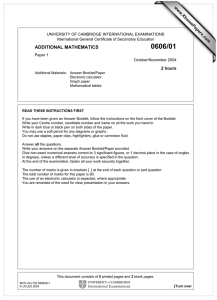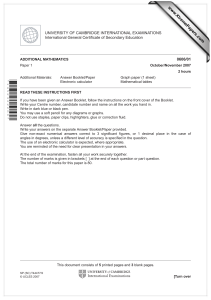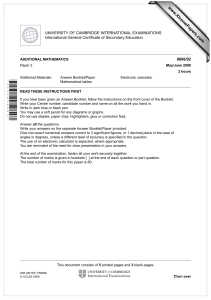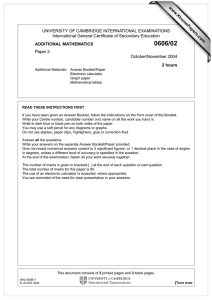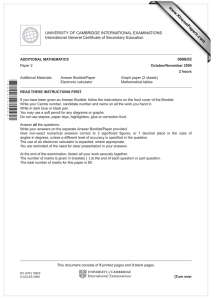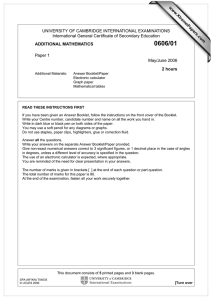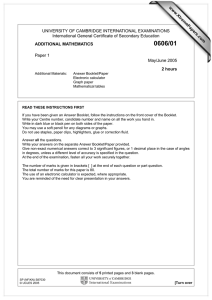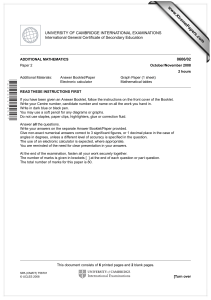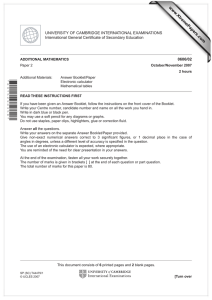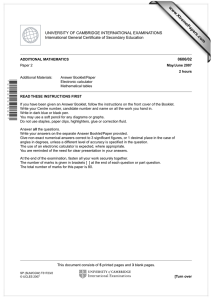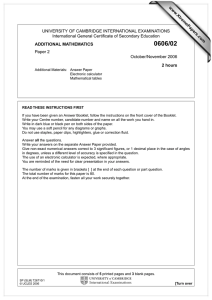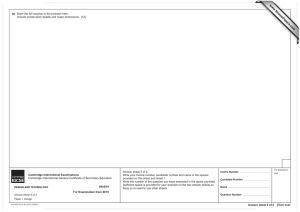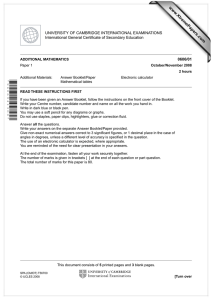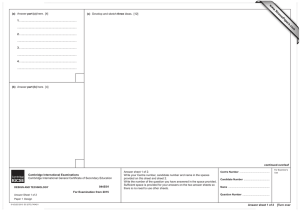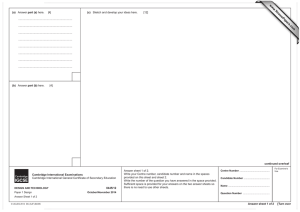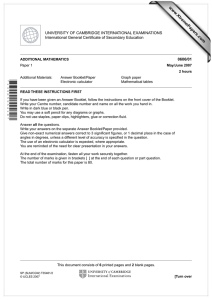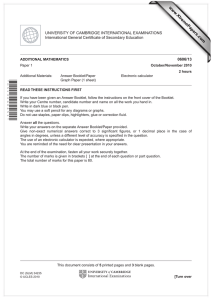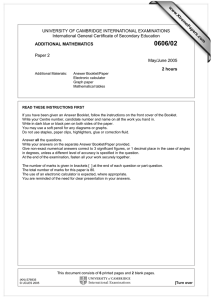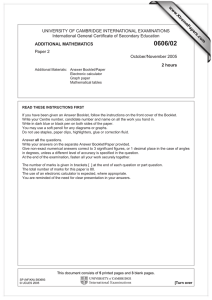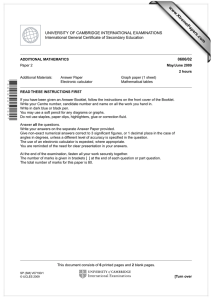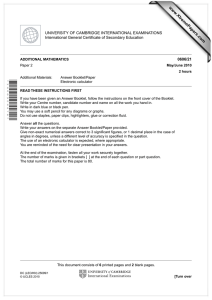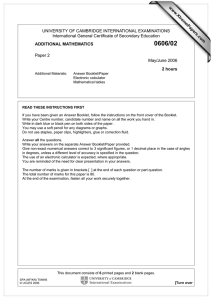www.XtremePapers.com
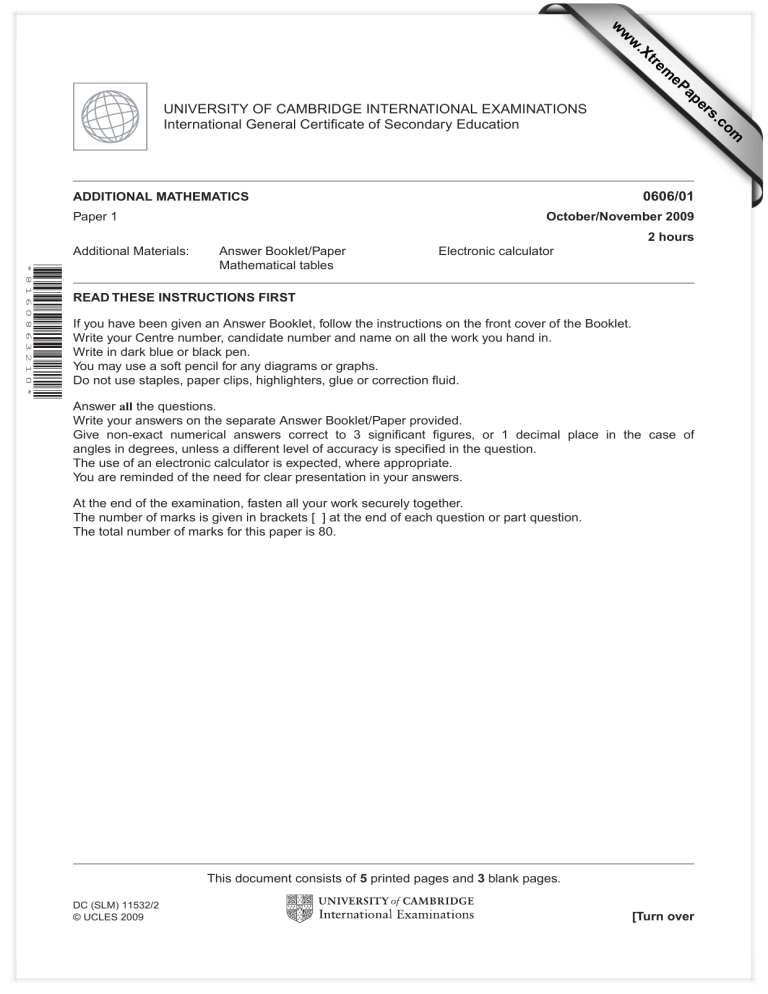
www.XtremePapers.com
UNIVERSITY OF CAMBRIDGE INTERNATIONAL EXAMINATIONS
International General Certificate of Secondary Education
ADDITIONAL MATHEMATICS
Paper 1
Additional Materials: Answer Booklet/Paper
Mathematical tables
0606/01
October/November 2009
2 hours
Electronic calculator
READ THESE INSTRUCTIONS FIRST
If you have been given an Answer Booklet, follow the instructions on the front cover of the Booklet.
Write your Centre number, candidate number and name on all the work you hand in.
Write in dark blue or black pen.
You may use a soft pencil for any diagrams or graphs.
Do not use staples, paper clips, highlighters, glue or correction fluid.
Answer all the questions.
Write your answers on the separate Answer Booklet/Paper provided.
Give non-exact numerical answers correct to 3 significant figures, or 1 decimal place in the case of angles in degrees, unless a different level of accuracy is specified in the question.
The use of an electronic calculator is expected, where appropriate.
You are reminded of the need for clear presentation in your answers.
At the end of the examination, fasten all your work securely together.
The number of marks is given in brackets [ ] at the end of each question or part question.
The total number of marks for this paper is 80.
DC (SLM) 11532/2
© UCLES 2009
This document consists of 5 printed pages and 3 blank pages.
[Turn over
2
Mathematical Formulae
1. ALGEBRA
Quadratic Equation
For the equation ax
2
+ bx + c = 0, x =
− b b
2 −
4
2 a
.
Binomial Theorem
(a + b) n
= a n
+
( n
1
) a
n–1
b +
( n
2
) a
n–2
b
2
+ … +
( r n ) a
n–r
b r
+ … + b n
, where n is a positive integer and
( r n )
=
n!
(n – r)!r!
.
Identities
Formulae for
∆
ABC
2. TRIGONOMETRY sin
2
A + cos
2
A = 1.
sec
2
A = 1 + tan
2
A.
cosec
2
A = 1 + cot
2
A .
a sin A
= b sin B c
= sin C
.
a
2
= b
2
+ c
2
– 2bc cos A.
∆
=
1
bc sin A .
2
© UCLES 2009 0606/01/O/N/09
3
1 Given that f (x) = 2x
3
– 7x
2
+ 7ax + 16 is divisible by x – a, find
(i) the value of the constant a,
(ii) the remainder when f (x) is divided by 2x + 1.
[2]
[2]
2
Place
Team
Harriers
Strollers
Road Runners
Olympians
1st
2
1
6
3
2nd
5
2
3
2
3rd
5
2
1
4
4th
0
7
2
3
The table shows the results achieved by four teams in twelve events of an athletics match. In each event, 1st place scores 5 points, 2nd place scores 3 points, 3rd place scores 2 points and 4th place scores 1 point.
(i) Write down two matrices whose product shows the total number of points scored by each team.
[2]
(ii) Evaluate this product of matrices. [2]
3
Find the values of
k
for which the equation
x
2
– 2(2 k + 1) x + ( k + 2) = 0 has two equal roots. [4]
4 Solve the simultaneous equations
A
x + 3y = 13, x
2
+ 3y
2
= 43. [5]
5
3 + 2
B C
3 – 2
The diagram shows a triangle ABC, where angle B is a right angle, the length of AB = 3 + length of BC = 3 – 2 .
2
and the
(i) Find the length of AC in the form k , where k is an integer.
(ii) Find tan A in the form a + b 2 c
, where a, b and c are integers.
© UCLES 2009 0606/01/O/N/09
[2]
[3]
[Turn over
4
6 Set A is such that A = {x : 3x
2
– 10x – 8 0}.
(i) Find the set of values of x which define the set A .
Set B is such that B = {x : 7 – 2x 1}.
(ii) Find the set of values of x which define the set A B.
[3]
[2]
7 A committee of 8 people is to be selected from 7 teachers and 6 students. Find the number of different ways in which the committee can be selected if
(i) there are no restrictions,
(ii) there are to be more teachers than students on the committee.
[2]
[4]
8 The number, N, of bacteria present in an experiment, t minutes after measurements begin, is given by
N = 1000e
–kt
, where k is a constant.
[1] (i) State the number of bacteria when t = 0.
When t = 0, the number of bacteria is decreasing at the rate of 20 per minute. Find
(ii) the value of k,
(iii) the time taken for the number of bacteria to decrease by 50%.
[3]
[3]
9 Differentiate, with respect to x ,
(i) (1 – 2x)
20
,
(ii) x
2 ln x ,
(iii) x
.
10 A curve has equation y = 3x
3
– 2x
2
+ 2x.
(i) Show that the equation of the tangent to the curve at the point where x = 1 is
y = 7x – 4.
(ii) Find the coordinates of the point where this tangent meets the curve again.
[4]
[5]
[2]
[3]
[3]
© UCLES 2009 0606/01/O/N/09
5
11 (a) Show that tan + cot = cosec sec .
(b) Solve the equation
(i) tan x = 3 sin x for 0 ° x 360 °,
(ii) 2cot
2 y + 3 cosec y = 0 for 0 y 2
π radians.
[3]
[4]
[5]
12 Answer only one of the following two alternatives.
EITHER
A solid circular cylinder has radius r cm and height h cm. The volume of the cylinder is 1000 cm
3
.
(i) Find an expression for h in terms of r.
(ii) Hence show that the total surface area, A cm
2
, of the cylinder is given by
[2]
A = 2
π r
2
+
2000 r
. [2]
(iii) Given that r varies, find, correct to 2 decimal places, the value of r when A has a stationary value.
[4]
[3] (iv) Find this stationary value of A and determine its nature.
OR y
y = x + cos 2x
A
B
O x
The diagram shows part of the curve y = x + cos 2x. The curve has a maximum point at A and a minimum point at B.
(i) Find the x-coordinate of the point A and of the point B.
(ii) Find, in terms of
π
, the area of the shaded region.
[6]
[5]
© UCLES 2009 0606/01/O/N/09
6
BLANK PAGE
0606/01/O/N/09
7
BLANK PAGE
0606/01/O/N/09
8
BLANK PAGE
Permission to reproduce items where third-party owned material protected by copyright is included has been sought and cleared where possible. Every reasonable effort has been made by the publisher (UCLES) to trace copyright holders, but if any items requiring clearance have unwittingly been included, the publisher will be pleased to make amends at the earliest possible opportunity.
University of Cambridge International Examinations is part of the Cambridge Assessment Group. Cambridge Assessment is the brand name of University of
Cambridge Local Examinations Syndicate (UCLES), which is itself a department of the University of Cambridge.
0606/01/O/N/09
